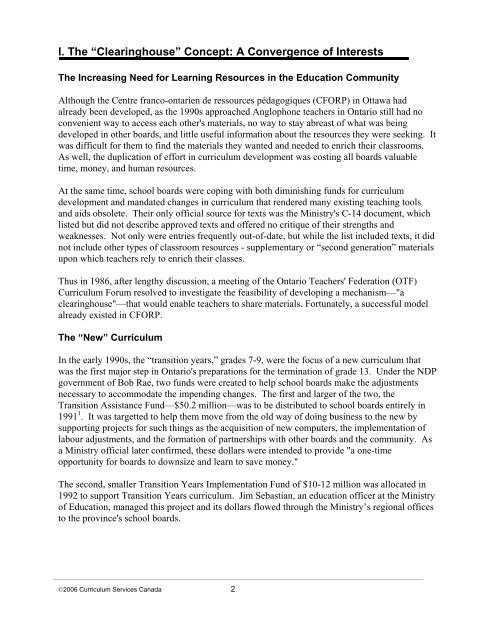a history of curriculum services canada
a history of curriculum services canada
a history of curriculum services canada
You also want an ePaper? Increase the reach of your titles
YUMPU automatically turns print PDFs into web optimized ePapers that Google loves.
I. The “Clearinghouse” Concept: A Convergence <strong>of</strong> Interests<br />
The Increasing Need for Learning Resources in the Education Community<br />
Although the Centre franco-ontarien de ressources pédagogiques (CFORP) in Ottawa had<br />
already been developed, as the 1990s approached Anglophone teachers in Ontario still had no<br />
convenient way to access each other's materials, no way to stay abreast <strong>of</strong> what was being<br />
developed in other boards, and little useful information about the resources they were seeking. It<br />
was difficult for them to find the materials they wanted and needed to enrich their classrooms.<br />
As well, the duplication <strong>of</strong> effort in <strong>curriculum</strong> development was costing all boards valuable<br />
time, money, and human resources.<br />
At the same time, school boards were coping with both diminishing funds for <strong>curriculum</strong><br />
development and mandated changes in <strong>curriculum</strong> that rendered many existing teaching tools<br />
and aids obsolete. Their only <strong>of</strong>ficial source for texts was the Ministry's C-14 document, which<br />
listed but did not describe approved texts and <strong>of</strong>fered no critique <strong>of</strong> their strengths and<br />
weaknesses. Not only were entries frequently out-<strong>of</strong>-date, but while the list included texts, it did<br />
not include other types <strong>of</strong> classroom resources - supplementary or “second generation” materials<br />
upon which teachers rely to enrich their classes.<br />
Thus in 1986, after lengthy discussion, a meeting <strong>of</strong> the Ontario Teachers' Federation (OTF)<br />
Curriculum Forum resolved to investigate the feasibility <strong>of</strong> developing a mechanism—"a<br />
clearinghouse"—that would enable teachers to share materials. Fortunately, a successful model<br />
already existed in CFORP.<br />
The “New” Curriculum<br />
In the early 1990s, the “transition years,” grades 7-9, were the focus <strong>of</strong> a new <strong>curriculum</strong> that<br />
was the first major step in Ontario's preparations for the termination <strong>of</strong> grade 13. Under the NDP<br />
government <strong>of</strong> Bob Rae, two funds were created to help school boards make the adjustments<br />
necessary to accommodate the impending changes. The first and larger <strong>of</strong> the two, the<br />
Transition Assistance Fund—$50.2 million—was to be distributed to school boards entirely in<br />
1991 1 . It was targetted to help them move from the old way <strong>of</strong> doing business to the new by<br />
supporting projects for such things as the acquisition <strong>of</strong> new computers, the implementation <strong>of</strong><br />
labour adjustments, and the formation <strong>of</strong> partnerships with other boards and the community. As<br />
a Ministry <strong>of</strong>ficial later confirmed, these dollars were intended to provide "a one-time<br />
opportunity for boards to downsize and learn to save money."<br />
The second, smaller Transition Years Implementation Fund <strong>of</strong> $10-12 million was allocated in<br />
1992 to support Transition Years <strong>curriculum</strong>. Jim Sebastian, an education <strong>of</strong>ficer at the Ministry<br />
<strong>of</strong> Education, managed this project and its dollars flowed through the Ministry’s regional <strong>of</strong>fices<br />
to the province's school boards.<br />
©2006 Curriculum Services Canada 2
















